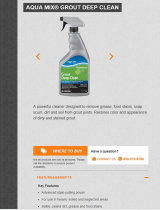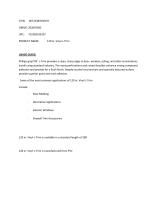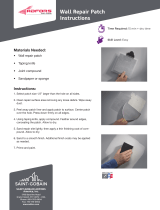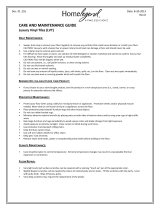
Installation Instructions
Self-Stick Luxury Vinyl Tile
For Assistance, Call: 1-877-527-0313
www.HomeDepot.com
Product Description
12 in. x 24 in. Tile, 10 Tiles, 20 sq. ft. Per Box
6 in. x 36 in. Plank, 24 Planks, 36 sq. ft. Per Box
Grade Levels
Above Grade / On Grade
Below Grade
Installation Method
Peel and Stick
HOMEDEPOT.COM
Please contact 1-877-527-0313 for further assistance.
CAUTION: ASBESTOS IN EXISTING FLOOR: This product does not contain asbestos. Existing installed resilient ooring and asphaltic adhesive may contain asbestos llers or crystalline silica. Do not sand, dry sweep, dry
scrape, drill, saw, bead-blast, or mechanically chip or pulverize existing resilient ooring, backing, lining felt, asphaltic “cutback” adhesive or other adhesive. See “Recommended Work Practices for Removal of Resilient Floor
Coverings” (rfci.com) for detailed information and instructions on removing all resilient covering structures.
CAUTION: DO NOT INSTALL IN all exterior installations, seasonal porches, boats, campers, RV's, sunrooms, solariums, non-temperature controlled rooms or homes.
Safety and Health Precautions
Power tools can be dangerous. Operate in strict accordance to manufacturer’s operating instructions and safety precautions. Unsafe and improper use can cause serious injuries. Avoid inhalation and exposures to airborne particles
by mechanical means and by wearing personal protective equipment. Wear appropriate personal protective equipment (PPE) which includes NIOSH or OSHA approve dust masks, safety goggles and work gloves.
Limited Lifetime Residential Warranty Covering DIY Residential Installations
The manufacturer warrants to the original purchaser that the product will be free from defects in material and workmanship during the warranty period as long as the purchaser remains in the residence of the original installation
provided the ooring is installed and maintained according to instructions included. The warranty is nontransferable and pro-rated. Color matching is not guaranteed if material is purchased from different lots. This warranty only
covers replacement of the same material on an equivalent product if purchased product is no longer available. This warranty does not include labor or the cost of labor for installation of the replacement ooring nor does it include
damage due to improper installation or maintenance, cleaners, water in the sub-oor, alkalis in sub-oor or conditions arising from hydrostatic pressure, burns, tears, indentions, scuff marks, stains, exterior application or long-term
exposure to the sun or ultra-violet light, deformation caused by extreme changes in temperature, or reduction in gloss due to normal use and or exterior applications. This warranty shall not include cost of labor for installation of the
replacement, loss of time, inconvenience, incidental expenses (such as telephone calls) included in the removal or reinstallation of the affected material, and any other incidental or consequential damages. Some states do not allow
the exclusion of or limitations of incidental or consequential damages so that above limitation and exclusion may not apply to you. This warranty gives you specic legal rights and you may have other legal rights, which varies from
state to state. This warranty is in lieu of any other warranties expressed or implied. This warranty service is available only by notice to the manufacturer through the dealer from whom the purchase was made. Notication must be
accompanied by a copy of the original invoice and can only be authorized by the manufacturer. Contact the Customer Service Team at 1-877-527-0313 or visit www.HomeDepot.com.
Pre-Installation
OWNER/INSTALLER RESPONSIBILITY
The owner is advised to be at home during the installation for consultation/direction. The owner and installer
should discuss installation and layout to maximize satisfaction. If this is not possible, consultation should be done
prior to installation. The owner/installer assumes all responsibility for product quality of completed installation.
PERFORM PRE-INSTALL INSPECTION. FOR CLAIMS PURPOSES, YOU ARE ALLOWED TO OPEN UP TO 4 BOXES FOR
PRODUCT INSPECTION. DO NOT OPEN ALL THE BOXES. OPENING ALL THE BOXES CONSTITUTES YOUR ACCEPTANCE
OF THE PRODUCT. INSPECT ALL THE TILES IN THESE 4 BOXES CAREFULLY. EXAMINE FLOORING FOR COLOR, FINISH
AND QUALITY. IF YOU DISCOVER THAT PRODUCTS ARE DEFECTIVE, OR IF MATERIAL IS QUESTIONABLE, YOU SHOULD
CONTACT THE RETAILER. IF YOU ARE SATISFIED, PROCEED WITH INSTALLATION.
Prior to installation, rack up planks/tiles from several boxes to ensure uniform distribution of colors, shades and
characters in the installed ooring. Planks/tiles having similar widths should be placed together in the same row
to minimize gaps between boards.
Purchase ooring to be installed in one large area at the same time. Product purchased at a later time than the
rst purchase may vary beyond your expectations.
Accessories, trims and moldings are manufactured to coordinate with the varied appearances of the oor planks/
tiles. Any exact matches are coincidental. Non-matching accessories are not defective products.
This product is manufactured according to strict quality standards. In the event that defects are discovered in the
eld, the industry standards permit a defect tolerance not to exceed 5%. Order an additional 10% extra for cutting
wastage and grading allowances (more for diagonal installations).
During installation, inspect the planks/tiles continuously. Defects that can be seen from a standing position
should be cut off or held out. Installing defective planks/tiles implies acceptance.
Clicking noises are the result of interactions among ooring, joists and suboors when they move. Sometimes,
it is impossible to eliminate them completely and minor clicking noises are to be accepted as normal ooring
phenomenon.
IMPORTANT: With square edge products, some ledging can be visible up to a .15 mm variance.
To assure the warranty is not inadvertently voided, before proceeding with any activity that is not covered in this
manual, please contact our Customer Support Team at 1-877-527-0313.
CONCRETE SUBFLOOR REQUIREMENTS
Concrete suboors must:
□ Have minimum rated strength of 3000 psi.
□ Be level to within 3/16 in. in a 10 ft. span; no bumps or low spots. High spots can be removed by grinding;
depressions can be lled with patching compound formulated for use in oor installation. Suboors should
not slope more than 1 in. per 6 ft.
□ Be clean; no construction debris, soil, mud and any other objects on or adhering to the oor; if necessary,
scrape and sweep away before the installation; no protrusions of nails, debris, metals should remain.
□ New concrete slab must cure for at least 90 days. It must have a minimum 10 mil polyethylene sheet
between the ground and the concrete.
□ Be free from moisture related conditions which can damage the installed ooring.
□ Do not install over a sealed suboor.
CONCRETE MOISTURE
Test all concrete suboors for moisture content and document the results with a photo. For full warranty
coverage, we recommend documenting your test results with a photo. Visual checks are not reliable.
Perform tests at locations around exterior doorways, near walls containing plumbing, near foundation walls
and in the center of the room. Minimum sample size is 3 samples per 1000 sq. ft. of area and one test for every
additional 1000 sq. ft. thereafter.
Moisture content should meet one of the following criteria:
□ 4% max. when tested using Tramex Concrete Moisture Encounter over bare concrete with no adhesive or
sealer.
□ Less than 3 pounds per 1000 sq. ft. per 24 hours when using Calcium Chloride test (ASTM F1869).
□ 85% max. when using Relative Humidity Testing (ASTM F2170).
NOTE: Concrete moisture content may be acceptable the time of the test. These tests do not guarantee a
perpetual “dry” concrete slab. The concrete slab moisture content can vary at other times of the year. We are
not responsible for moisture-related damage to installed ooring.
WOOD SUBFLOOR REQUIREMENTS
The suboor must be clean; no presence of construction debris, soil, mud and any other objects on or adhering
to the oor; no protrusions of nails, debris, or metals should remain. If necessary, scrape and sweep the suboor
before the installation.
The suboor must be structurally sound and stable; no movements or squeaks; no loose panels or loose nails; no
signs of ply de-lamination or other damages. Repair all shortcomings before installation.
The suboor must be at; no visible bumps or low spots; the suboor should be at to within 3/16 in. in 10 ft.
span. Test for moisture using a reliable pin type meter. Perform tests at locations around exterior doorways, near
foundation walls, near walls containing plumbing lines and in the center of the room. Moisture levels should not
exceed 12%.
PLYWOOD
Panels shall be exterior underlayment grade, sanded face, properly installed and secured with 1/8 in. gap
around the perimeter of the room. Do not install over chipboard, OSB, luan plywood, mohagany-based plywood
underlayments, Masonite™, cement board, ber-based backing boards, or any other non-underlayment grade
panels.
EXISTING RESILIENT FLOORING
Existing oor coverings must be tightly secured and bonded. Remove any contaminants, waxes, sealers from
the surface and cover with a suitable cementitious embossing leveler. Do not cover loose-lay, oating ooring or
cushion backed vinyl with DIY Self-stick ooring.
EXISTING FLOORS
Installation over existing oor requires the installer to consider potential issues related to moisture damage,
adhesive failure and fastener failure. Contact the adhesive and fastener manufacturers respectively for their
specic instructions, recommendations and requirements.
Do not install over nished or pre-nished hardwood ooring, polyurethane or varnished nishes.
Acceptable oor coverings include: Solid hardwood (smooth, securely fastened and within acceptable moisture
levels), linoleum (one layer only), terrazzo, ceramic, and stone tile. Tiled oors with grout lines will require a
cementitious leveling compound to ll any grout lines, voids, or cracks.
Unacceptable oor coverings include: Carpet (any type), foam underlayment, cushioned-back vinyl, rubber, cork,
laminates, free-oating oors, and wooden oors over concrete.
JOB SITE CONDITION
Prior to installation, the installer must ensure that at the time of installation, the job site conditions including
suboor/substrate, ambient temperature and relative humidity, and all impacting variables will not negatively
affect the oor. The manufacturer will decline responsibility for damages associated with improper installation
or poor site conditions.
STORAGE AND CONDITIONS
Acclimate the ooring a minimum of 48 hours before installation in the area it is to be installed. Conditions
between 65°F and 85°F (18°C and 29°C) are required before, during and after installation. Cartons should be
evenly stacked no more than ve high on a at surface and away from any heating/cooling ducts or direct
sunlight.
EXISTING HOME
An existing home should have a consistent room temperature between 65°F and 85°F (18°C and 29°C) and
relative humidity (RH) of 35%-85%. Continual deviation from these conditions will affect the dimensions of
ooring. When using a heater during winter months, humidity may be much lower than the acceptable range.
During the warmer months, maintain humidity levels using an air conditioner, dehumidier, or by turning on your
heating system periodically.
NEW CONSTRUCTION OR REMODEL
All work involving water, such as pouring basement concrete oors, drywall and plasterwork, plumbing,
etc. must be completed well in advance of the oor delivery. Ensure that the building is enclosed. Where
building codes allow, permanent heating and/or air conditioning systems should be operating at least two
weeks preceding installation and should be maintained during and after installation. If it is not possible for
the permanent heating and/or air conditioning system to be operating before, during and after installation,
a temporary heating and/or dehumidication system that simulates normal living (occupied) conditions
can enable the installation to proceed until the permanent heating and/or air conditioning system is fully
operational. Your job site should have a consistent temperature between 65°F and 85°F (18°C and 29°C) and
relative humidity (RH) of 35%-85% which should be maintained continuously thereafter.
RECOMMENDED INSTALLATION AREA
Do not install vinyl planks/tiles over carpet or any foam underlayment. This product is not suitable for any
outside use, sunrooms/solariums, saunas, seasonal porches, camping trailers, boats, RV’s or rooms that have
a potential of ooding. Do not install in rooms or homes that are not temperature controlled. Do not install in
garages or areas that will be damp. Do not install on below grade concrete or concrete that has been painted or
contains any contaminants, grease, oil, solvents, or stains.
BASEMENTS AND CRAWL SPACES
Concrete slab or ground must be dry. Ensure that crawl spaces have open vents year round to ensure proper air
circulation and prevent moisture build up. The ground in the crawl spaces must be completely covered using 6
mil black polyethylene. Crawl space clearance between the earth and underside of joists should be no less than
18 in. and the perimeter vent area should be equal to 1.5% of the total square footage of the crawl space or as
mandated by code.
RADIANT HEATED SUBFLOOR
This product can be installed over radiant heat concrete suboors. The radiant heating system must be cast
1/2 in. below the surface of the concrete slab and should be operating at least 2 weeks before installation. Set
the temperature of the radiant heating system to 68°F 48 hours before, during, and 72 hours after installation.
You may gradually raise the temperature starting 72 hours after installation. The nished oor surface must
not exceed 85°F (29°C) for the life of the oor. Because radiant heat creates a dry heat that can lower interior
humidity levels, it may be necessary to add a humidier to maintain the humidity level between 30-85% to
prevent damage to the vinyl oor. Consult with the radiant heat system manufacturer to ensure that the system
is compatible with vinyl ooring.
MOISTURE BARRIER/UNDERLAYMENT PADDING
CONCRETE SUBFLOOR
When installing over a crawl space or concrete slab, it may be necessary to use a moisture barrier to prevent
moisture migration. A plastic lm with a minimum thickness of 6 mil should be placed with a 4 – 6 in. (101.6 –
152 mm) overlapped seam, and taped with a suitable tape.
EXPANSION GAP
A required gap width of 1/4 in. is required around the perimeter of the oor and between the oor and all
vertical obstructions. Do not place permanently mounted structures such as kitchen counters/cabinets on the
installed oor.
TRANSITION MOLDING
For oating installation, transition T-molding is required in the following cases: oors spanning greater than 30
ft. in width and 50 ft. in length; doorways and archways less than 4 ft. wide.
TOOLS AND MATERIALS BASICS
Required (not included): Chalk line • Tape measure • Shop vacuum • Pencil • Utility knife with blades •
100 lb. 3 section roller (available at Home Depot Rental department) • Carpenters or speed square
Helpful (not included): Reducer strip or moldings • Wall trim • Putty knife • Crowbar • Cementitious latex
based patching compound* • Finishing nails • Claw hammer
*Cement based patch is required when installing over existing oor coverings.
Helpful Pointers
GENERAL TIPS
□ Make sure your work area is well lit. Good visibility ensures that color is consistent and that visually defective tiles are detected and removed.
□ Accurate measurements and a at, clean and dry suboor are essential for a successful installation. Self-stick adhesives will not stick to dirt, dust or high-moisture content suboors.
□ NEVER ADD ADDITIONAL ADHESIVE TO SELF-STICK TILES, REGARDLESS OF THE TYPE OF ADHESIVE.
IMPORTANT: NEVER use solvent-based or chemical oor preparation materials. Do not use primers or llers that are manufactured for use with paint or products other than vinyl ooring.
Never use solvent-based or chemical care and maintenance products, renishing products or waxes on this vinyl ooring.
□ Pieces can be cut with a square and razor knife by scoring the top surface of the piece and snapping the pieces apart. It is not necessary to cut all the way through the piece. For intricate cuts around door jambs or moldings,
heat the piece slightly with a hair dryer to allow the piece to be fully cut with the razor knife.
Preparing for Installation
□ Ensure suboors are clean.
□ Inspect all pieces for visible blemishes or defects and remove them from the installation. Installation of a defected piece will be regarded as acceptance of its condition regardless of the defect and will void the product
warranty.
□ Cartons should be mixed on the jobsite and pieces installed from multiple cartons at the same time.
□ Ensure cartons are obtained from the same lot / run number to avoid differences in pattern or shading which may occur.
□ Remove the existing base, shoe molding or threshold carefully. They can be used to cover the 1/8 in. expansion gap left around the edge of the room.
□ Undercut doors and casings using a handsaw laid at on a piece of scrap ooring. Never undercut metal door casings.
Suboor Preparation
□ Suboor must be level to 1/4 in. within each 10 ft. radius. Fill low areas with cementitious based latex patching compound (not included). Grind, chip or sand down any high areas in the ooring.
□ Sweep and thoroughly vacuum the suboor.
□ Prime the suboor with latex-based ooring primer (not included). Primer must be of type specically designed for use with self-adhesive (self-stick) vinyl ooring. Follow the manufacturer’s directions for proper application
and mixing of ooring primer.
Installation
1. INSTALLING THE FIRST ROW
a. Plan your layout to avoid an unbalanced installation with pieces shorter than 9 in. or narrower than
1/2 the width of the piece or tiles along the walls.
b. Dry lay a section of ooring in width and length from the centerline of the room and adjust your
layout accordingly to avoid small pieces.
c. When the starting row is determined, strike a line parallel to the wall farthest from the door. If the
rst row of pieces is to be cut add this measurement to the width of a full piece and use this as your
starting line. Be sure to account for irregularities in the wall and allow for a 1/8 in. expansion gap
between the pieces and the wall. This is your starting line.
d. Remove the release paper from the rst piece and place it along the starting line. Discard release
paper immediately; it is very slippery and may cause a fall or injury if stepped on.
e. Set the second piece snug against the end of the rst piece and along the starting line. Continue the
remainder of the rst row in this manner.
NOTE: If you are installing tiles and planning on using grout be sure to insert the proper size spacers
between all tiles during the installation.
f. For the last piece which will be cut, allow for a 1/8 in. expansion space at the wall. Use the remainder
of the cut piece to start the next row placing the cut edge against the wall.
1.1 1.2 1.3
2. INSTALLING THE SECOND AND REMAINING ROWS
a. Continue to install the rows of pieces in this fashion until the last row is reached. Seams should be
tight with no gaps. Stagger end joints in each row by at least 6 in. and try to avoid “stair stepping” of
joints. Random placement of end joints offers a more authentic look to the installation.
b. During installation, roll pieces and tiles with a 100 lb. 3-section vinyl roller. This is necessary to
activate the adhesive and provide maximum bonding to the substrate.
c. ROWS ALONG THE WALLS: If the pieces along the long side walls need to be cut in width, use a
suitable straight edge that is slightly longer than the piece. Mark both ends of the piece to the proper
width and score the piece with the utility knife, using the straight edge as a guide. Snap the piece in 2
along the score line and install the cut piece along the wall. Be sure to maintain the 1/8 in. expansion
gap along all walls.
2.1 2.2
3. COMPLETING THE INSTALLATION
a. After installation, roll the complete oor in length and width with a 100 lb. 3-section steel roller. The adhesive on the pieces is a pressure-sensitive adhesive and this step ensures a complete bond to the substrate. Failure to
roll the oor may result in loose or curled pieces of ooring.
b. For installations that will be utilizing grout with Luxury Vinyl Tiles:
□ Wait minimum of 12 hours before grouting.
□ Follow the manufacturer’s recommendations on installing the grout and cleaning excess grout from the tiles.
□ Do not use haze removers or other types of chemical tile cleaners as they might damage the nish on the vinyl tiles.
c. Ensure all pieces are set at and have tight edges. Re-roll if necessary to ensure all tiles are properly set into the adhesive.
d. Replace any wall trim and moldings. Be sure to secure quarter round moldings to the baseboard and not through the ooring.
NOTE: Save any leftover tiles. Do not discard as they are color matched (dye-lot) to your oor. They can be used for replacement in the event you need to replace a tile in the future.

Installation Instructions
Self-Stick Luxury Vinyl Tile
For Assistance, Call: 1-877-527-0313
www.HomeDepot.com
Product Description
12 in. x 24 in. Tile, 10 Tiles, 20 sq. ft. Per Box
6 in. x 36 in. Plank, 24 Planks, 36 sq. ft. Per Box
Grade Levels
Above Grade / On Grade
Below Grade
Installation Method
Peel and Stick
HOMEDEPOT.COM
Please contact 1-877-527-0313 for further assistance.
Accessories
Pictures are for general illustrative purposes only. Actual products may differ from pictures.
□ Clean the oor.
□ Install or reinstall all wall trim pieces. Nail them through the wall, but not to the suboor to avoid restricting the expansion gap.
□ Install transition trim pieces. Nail them to the suboor, not the ooring.
□ At doorways, transitions should be used to protect the edges of the oor and to provide a decorative transition from one oor type to another.
□ If the oor is to be covered, use a breathable material such as cardboard. Do not cover with plastic.
T-Molding: Used to create a transition between oor coverings of similar heights or to cover an expansion gap.
T-MOLDING
FLOORING
FLOORING
Stair Nose: Used in conjunction with ooring installed on stair steps or nished edges of a higher level oor
like in a sunken living room.
FLOORING STAIR NOSE
RISER
STAIR TREAD
Hard Surface Reducer: Used to transition to another hard surface ooring of different heights such as tile,
vinyl, or concrete.
HARD SURFACE
REDUCER
RESILIENT
FLOOR
FLOORING
Quarter Round: Used to cover the expansion space between the wall base and your ooring. It can also
be used to make smooth transitions between the oor and cabinetry. It can be used with or without wall base
molding. Ensure you nail the quarter round to the wall and not the ooring, as shown.
FLOORING
QUARTER ROUND
WALL
Care and Maintenance
DAILY MAINTENANCE
□ Sweep, dust, damp mop, or vacuum your oor regularly to remove any particles that could cause abrasion or scratch your oor.
CAUTION: Vacuums with a beater bar or power rotary brush head can damage a oor and should never be used.
□ Use a damp mop to remove spots and soil. Use any high-quality, pH-neutral vinyl cleaner. Alternatively, use a non-rinsing, biodegradable cleaner that leaves no residue or haze.
□ For lightly soiled area, clean with distilled water.
□ HINT: For best results, clean the oor in the same direction of the tiles. When the cleaning cloth/mop becomes soiled, rinse or replace it with a clean one. Following up with a clean, dry cloth will remove residual streak marks
and spots.
□ Do NOT leave any amount of liquids (water, juice, soft drinks, spills, etc.) on the oor. Clean any wet spots immediately.
□ Do NOT use a wet mop or douse the oor with water or liquid cleaners. Liquid can seep between the cracks and cause moisture damage.
□ Do NOT use any cleaning agents containing wax, oil or polish. Left over residue will form a dull lm.
□ Do NOT use steel wool or scouring powder which will scratch the oor.
□ Do NOT use any dust cleaners, as they may cause your oor to become slick or damage the nish.
□ Avoid spills of paints, dyes, or harsh chemicals.
□ Avoid long term exposure to direct sunlight. High temperatures directly on the oor may cause the adhesive to reactivate and release from the suboor. Use window treatments or UV tinting on windows.
BRANDED OR OFF-THE-SHELF FLOOR CARE PRODUCTS
If none of the above are effective and you choose to use a store bought product, test the product in a non-conspicuous area (i.e., closet, corner, or scrap pieces) for potential adverse side effects.
PREVENTATIVE MAINTENANCE
□ Protect your oor when using a dolly for moving furniture or appliances. Protective sheets and/or plywood may be needed. Never slide or roll heavy furniture or appliances across the oor.
□ Use at oor protectors (nylon or felt) on all furniture legs. Clean protectors periodically to remove grit that may become embedded and cause scratching.
□ Avoid excessive exposure to water from being tracked in during periods of inclement weather.
□ Minimize abrasive material and dirt by placing mats on both sides of exterior doors and by using area rugs in high-trafc areas
□ Rearrange furniture and rugs periodically to avoid uneven color and shade changes from light exposure.
□ Use protective mats beneath rolling chairs and keep furniture casters clean.
□ Use NON-RUBBER backed mats at all entrances to reduce the walk-off residue from asphalt driveways as well as prevent dirt and grit from being tracked onto your oor. Rubber backed mats can discolor your oor.
□ We recommend the use of a hard surface (non-studded), non-rubber chair mat to protect your oor from ofce chairs with casters. Light, rolling furniture should be outtted with broad-surface, non-staining casters that have
been engineered for hard surface oors. Such casters should be a minimum of 1 in. (2.5 cm) wide and at least 2 in. (5.1 cm) in diameter.
□ Keep pets’ nails trimmed.
□ Remove shoes with cleats, spikes or exceptionally pointy heels before walking on the oor.
TREATING STAINS, SPILLS, AND SCUFFS
Follow the remedies in order. Unless instructed otherwise, use a clean, white cloth or towel with products recommended for our LVT ooring. Always rinse the affected area with clean water after treatment.
□ For most stains and spills such as acids, alkalis, foods, and rust: First, remove as much of the spill as possible. Scrub the area with a full strength cleaner. Rub the area with a 10/1 dilution of water/liquid bleach. Rub the area
with isopropyl alcohol. If rust stain does not respond, use lemon juice or a cream of tartar solution.
□ For paint and solvent spills such as dry cleaning fluids, paints, nail polish, and wood stains: If the substance is dry, gently peel it from the oor. Avoid sharp instruments that could scratch the oor. Scrub the area with a non-
abrasive cleaner. Rub lightly with odorless mineral spirits or paint thinner.
NOTE: Do not use acetone or nail polish remover!
□ For substances that do not wipe up such as adhesives, chewing gum, oil, and grease: First, remove as much solid material as possible. Carefully remove excess with a spoon or ngernail. Scrub the area with non-abrasive
cleaner. Rub lightly with odorless mineral spirits, isopropyl alcohol or lighter uids.
□ For scuffs and smudges: Rub the scuff with your ngertip. The friction from the rubbing will remove rubber. Scrub the area with non-abrasive cleaner. Rub lightly with isopropyl alcohol or lighter uid.
CLIMATE MAINTENANCE
□ Care should be taken to control humidity levels within the 35% - 85% range to avoid excessive movement within the oor.
□ Dry Climates: A humidier is recommended to maintain humidity levels. Wood stoves and electric heat tend to create very dry conditions during the winter months this also will cause shrinkage in ooring.
□ Humid, Wet Climates: By using an air conditioner, heater, or dehumidier proper humidity levels can be maintained to prevent excessive expansion due to high moisture content.
FLOOR REPAIR
□ Very deep scratches may require the replacement of the tiles.
USE OF FINISHES
□ If a nish coat is desired, use a matte nish designed for vinyl ooring only. Avoid use of waxes.
□ If a nish is applied this will become part of the regular maintenance and may require periodic stripping and reapplication of the nish.
/





